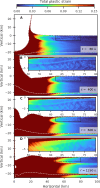Multiring basin formation constrains Europa's ice shell thickness
- PMID: 38507497
- PMCID: PMC10954210
- DOI: 10.1126/sciadv.adj8455
Multiring basin formation constrains Europa's ice shell thickness
Abstract
Jupiter's moon Europa hosts a subsurface ocean under an ice shell of uncertain thickness. Europa has two multiring basins that exhibit several concentric rings. The formation of these multiring basins is thought to be sensitive to the thickness and thermal structure of the ice shell. Here, we simulate multiring basin forming impacts on Europa finding that a total ice shell greater than 20 kilometers thick is required to reproduce observed ring structures. Thin ice shells (<15 kilometers thick) result in compressional tectonics inconsistent with observed ring structures. Our simulations are also sensitive to the thermal structure of the ice shell and indicate that Europa's at least 20-kilometer ice shell is composed of a 6- to 8-kilometer-thick conductive lid overlying warm convecting ice. The constraints on Europa's ice shell structure resulting from this work are directly relevant to our understanding of the potential habitability of Europa.
Figures




References
-
- Khurana K. K., Kivelson M. G., Stevenson D. J., Schubert G., Russell C. T., Walker R. J., Polanskey C., Induced magnetic fields as evidence for subsurface oceans in Europa and Callisto. Nature 395, 777–780 (1998). - PubMed
-
- Kivelson M. G., Khurana K. K., Russell C. T., Volwerk M., Walker R. J., Zimmer C., Galileo magnetometer measurements: A stronger case for a subsurface ocean at europa. Science 289, 1340–1343 (2000). - PubMed
-
- Hoppa G. V., Tufts B. R., Greenberg R., Geissler P. E., Formation of cycloidal features on europa. Science 285, 1899–1902 (1999). - PubMed
-
- Greenberg R., Geissler P., Tufts B. R., Hoppa G. V., Habitability of Europa’s crust: The role of tidal-tectonic processes. J. Geophys. Res. Planets 105, 17551–17562 (2000).
-
- O’Brien D. P., Geissler P., Greenberg R., A melt-through model for chaos formation on Europa. Icarus 156, 152–161 (2002).
LinkOut - more resources
Full Text Sources

